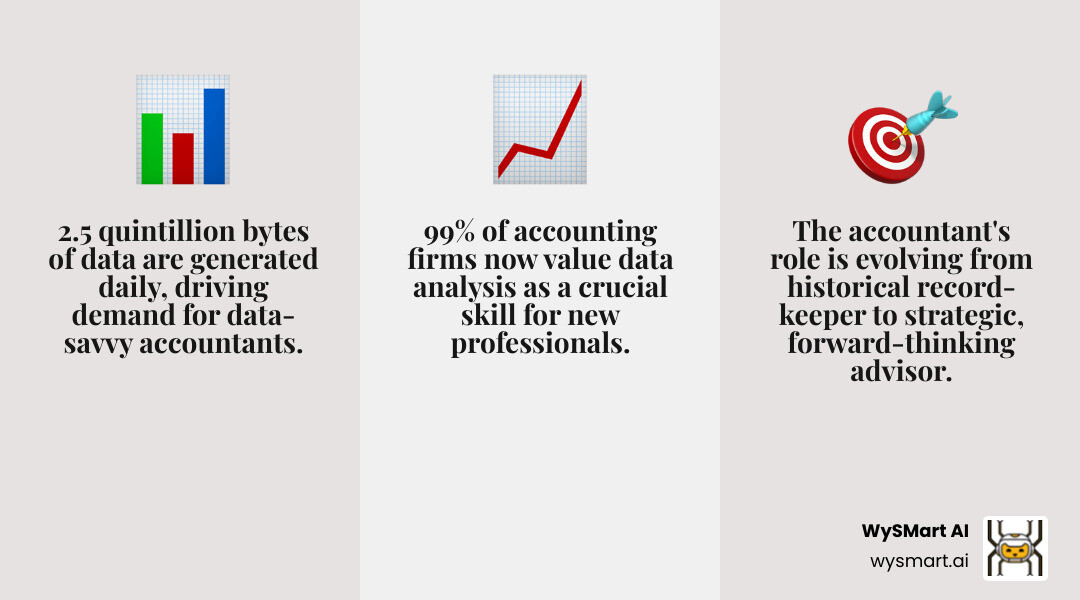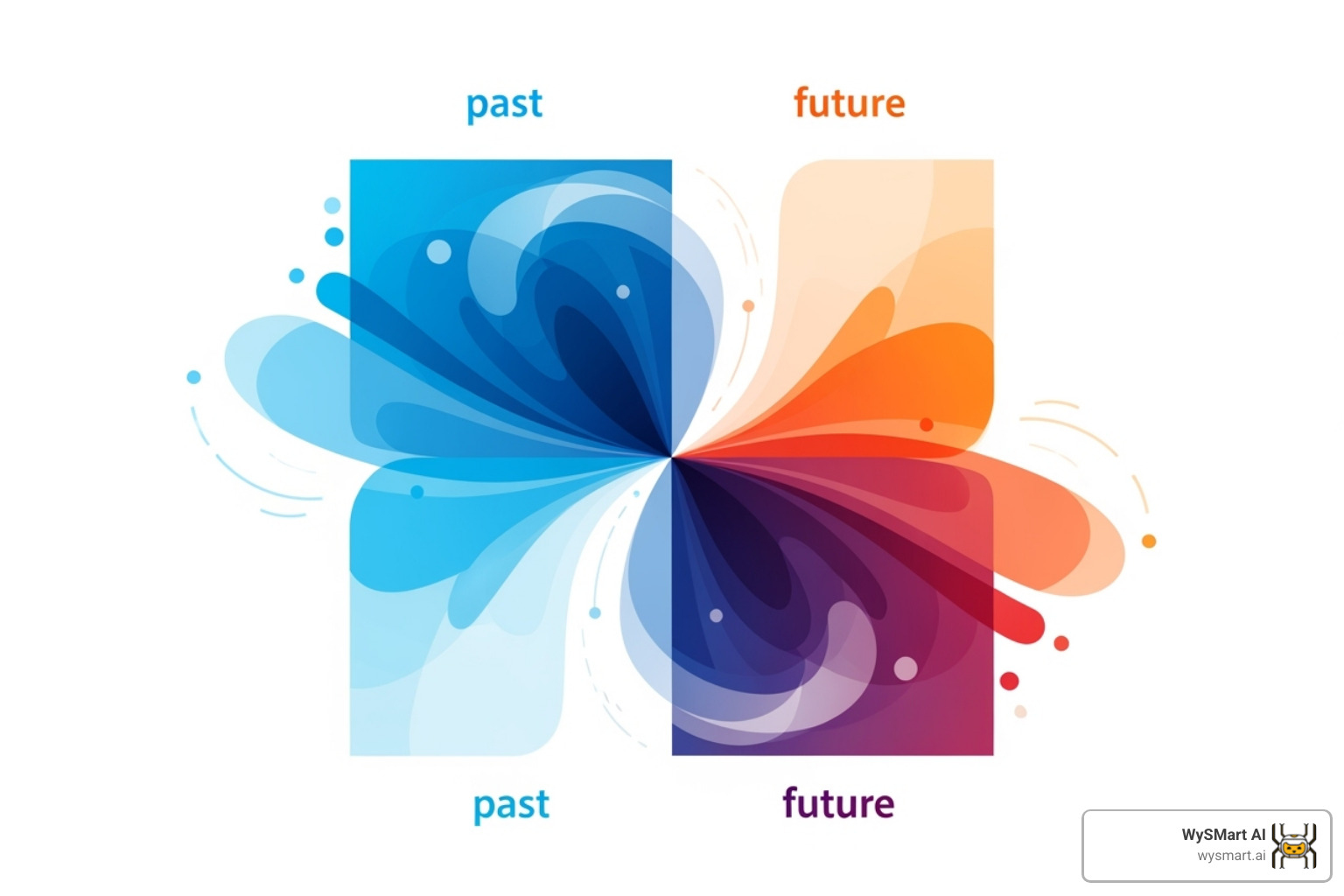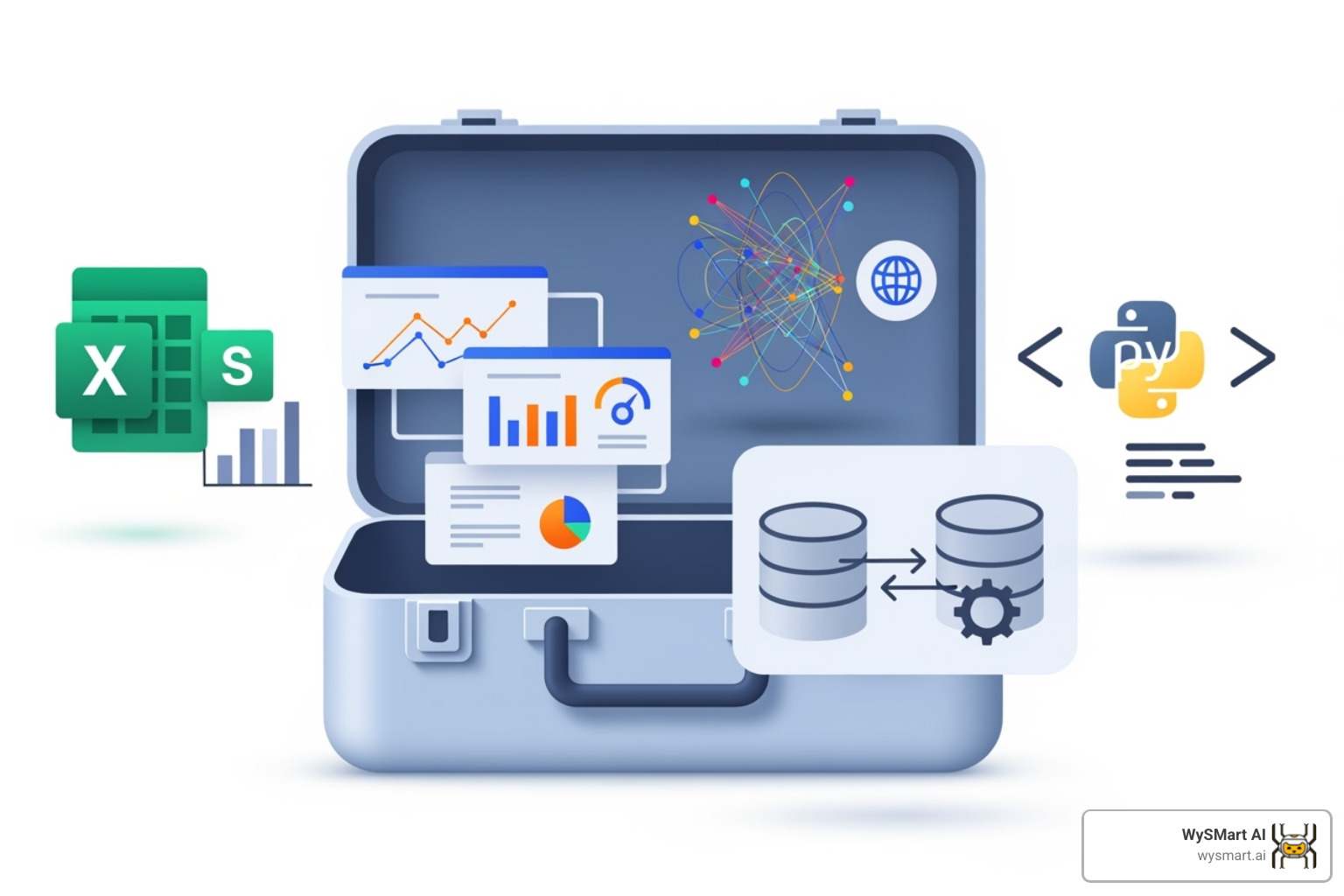
Accountants, Meet Your New Best Friends: AI and Data Analytics
Why Analytics for Accountants is the Game-Changer Your Practice Needs
Analytics for accountants transforms traditional bookkeeping into strategic business consulting, using data to predict trends, identify opportunities, and drive client success. Here's what you need to know:
Key Benefits:
Improve audit quality - Analyze 100% of transactions instead of samples
Improve forecasting - Use predictive models for accurate budgets
Identify risks - Spot fraud and compliance issues early
Provide advisory services - Move beyond compliance to strategic guidance
Increase efficiency - Automate routine analysis tasks
Four Types of Analytics:
Descriptive - What happened? (financial statements, KPIs)
Diagnostic - Why did it happen? (variance analysis, root causes)
Predictive - What will happen? (forecasting, trend analysis)
Prescriptive - What should we do? (recommendations, optimization)
Essential Tools: Excel, Power BI, Python, specialized audit software
The accounting profession is in a digital revolution. Accountants are evolving from financial historians to strategic advisors, using data to guide clients through an uncertain future. With 2.5 quintillion bytes of data generated daily, it's no surprise that 99% of accounting firms now prioritize data analysis skills.
Accountants are perfectly positioned for this shift. You already have the business context and analytical skills to turn complex data into actionable insights. The move is from manual number-crunching to automated analysis, from historical reports to forward-thinking predictions, and from compliance to value-added advisory.
I'm Joey Martin, founder of WySMart.ai. Through my work with hundreds of business owners, I've seen how analytics for accountants creates competitive advantages and transforms client relationships by helping businesses harness AI-powered tools for growth.

The Evolution of Accounting: Why Data Analytics is No Longer Optional
The accounting profession is undergoing a dramatic change, far greater than the move from paper to spreadsheets. The traditional role, focused on historical compliance and periodic reporting, provided a snapshot of the past. However, it was often too slow and limited in scope to guide future strategy effectively. Today, with 2.5 quintillion bytes of data generated daily, businesses face an enormous opportunity and a significant challenge. Raw data is a puzzle, useless until an accountant with analytical skills puts the pieces together to reveal the full picture.
This is where analytics for accountants becomes essential. You're no longer just recording what happened last month; you're helping predict what will happen next quarter and advising on the best path to success. The shift is from being a scorekeeper to being a key player on the business strategy team.

The profession has taken notice, with 99% of accounting firms now valuing data analysis skills in new hires. The firms that accept this evolution are changing from historians into visionaries, and their clients are reaping the benefits. This shift represents a fundamental change in how accountants create value, moving from compliance and historical reporting to becoming a strategic partner who helps businesses steer uncertainty and find growth opportunities.
What is Data Analytics and Why is it Crucial?
Data analytics is like detective work for numbers. You're not just organizing information—you're uncovering the stories hidden within financial data and turning them into actionable business intelligence. For instance, a simple analysis of payment patterns might reveal that clients who pay within 15 days are 40% more likely to increase their orders. A deeper dive might involve helping a retail client analyze point-of-sale data. By correlating sales figures with weather patterns, local events, and marketing campaigns, you could discover that a specific product sells 200% better on rainy Tuesdays, allowing the client to optimize inventory and staffing for those days.
The real power lies in making data-driven decisions that move businesses forward. Modern analytics helps you uncover valuable insights about customer behavior, identify process improvements, and strengthen risk management. Your clients want to know why revenue changed, what's likely to happen next, and what actions they should take. This shift from reactive reporting to proactive consulting creates a tremendous competitive advantage and dramatically increases your client value.
The New Role of the Accountant as a Data Scientist
Accountants already possess many of the skills that make excellent data scientists. You're natural problem-solvers who understand business context in ways that pure tech professionals often don't. Your expertise in financial regulations, tax law, and business operations provides an essential framework for any analysis. A data scientist might build a perfect predictive model, but an accountant can interpret its output in the context of GAAP or IFRS and explain its real-world financial implications.
Your existing technical skills with financial systems give you a head start. Most importantly, you can see the bigger picture and translate complex patterns into clear recommendations that business owners can use. You are perfectly positioned to bridge the gap between raw data and business strategy. As research from Kenan-Flagler shows, accountants who accept analytics aren't replacing their core skills—they're amplifying them with powerful new tools, adding a layer of strategic foresight to their foundational expertise.
The Four Pillars of Analytics for Accountants
Imagine analytics for accountants as a journey through time, moving from understanding the past to shaping the future. These four pillars transform you from a reporter of numbers into a strategic advisor. It's like having four different superpowers, each one building on the last, allowing you to answer progressively more complex and valuable questions for your clients.

Descriptive Analytics: What Happened?
This is your foundation, the bedrock of all analysis. Descriptive analytics takes raw financial data and turns it into clear stories about what happened. It's your toolkit for creating intuitive dashboards with key performance indicators (KPIs) like Days Sales Outstanding (DSO), Customer Acquisition Cost (CAC), and Customer Lifetime Value (LTV). It's used for generating essential financial reports, and organizing revenue analysis. When you categorize expenses or track cash flow, you're using descriptive analytics. The key is to present this information in a way that sparks curiosity and prompts further questions, such as highlighting that last month's sales figure represents a 15% increase over the same period last year, while gross margin has simultaneously decreased by 5%.
Diagnostic Analytics: Why Did It Happen?
Here, you become a financial detective, digging deeper to uncover the "why" behind the numbers revealed by descriptive analytics. Diagnostic analytics is about conducting variance analysis to understand why actual results differ from the budget. Root cause identification is your specialty. For example, if descriptive analytics shows sales are down, diagnostic analytics drills down to find the cause. You might discover that overall sales are down because the Western region missed its target by 40%. Drilling further, you find that the region's top-selling product had a supply chain disruption, causing a two-week stockout. The drill-down capabilities of modern tools let you investigate these issues at a granular level, moving from a high-level problem to a specific, actionable cause.
Predictive Analytics: What Will Happen Next?
This is where you become a data-driven fortune teller, moving from hindsight to foresight. Predictive analytics uses historical patterns, statistical algorithms, and machine learning techniques to forecast the future. You can use time-series analysis to create accurate cash flow projections and regression models to build revenue forecasts that consider market conditions, seasonality, and economic indicators. Budgeting becomes a realistic financial roadmap instead of wishful thinking. One of the most valuable applications is identifying at-risk clients by analyzing leading indicators like declining product usage, late payments, and reduced communication, allowing you to intervene before they churn. For CPAs looking to master this, specialized training in Data Analytics for CPAs: Predictive Analytics can provide a strong technical foundation.
Prescriptive Analytics for Accountants: What Should We Do?
This is the pinnacle of analytics, where you transform from advisor to strategist. Prescriptive analytics not only predicts what will happen but recommends exactly what to do about it. You provide actionable recommendations, moving from "Here's what I see" to "Here's what you should do." For example, after predicting a potential cash shortfall in Q3, a prescriptive model could recommend the optimal combination of drawing on a line of credit versus delaying specific vendor payments to maintain liquidity. You can advise clients on optimizing resource allocation for marketing or operations based on analytical evidence. Scenario modeling lets you run "what-if" analyses to explore the financial impact of different strategic choices, such as modeling the net profit impact of a 5% price increase versus a 10% increase in marketing spend. This level of strategic planning support transforms your client relationships, making you the indispensable advisor they turn to before making major business moves.
Gearing Up: Essential Skills, Tools, and AI Synergy
Building your analytics for accountants capabilities is like assembling a toolkit for the modern era. You don't need to become a computer scientist overnight, but a commitment to continuous learning is your competitive edge. The firms that thrive are those that blend traditional accounting wisdom with modern analytical capabilities, creating a powerful combination that clients can't find elsewhere.

Key Skills for the Modern Accountant
Your deep understanding of business acumen is what separates you from a generic data analyst. Beyond that, focus on honing these key skills:
Critical Thinking: This is about more than just finding errors. It's the ability to look at a data set and ask insightful questions. A data analyst sees a spike in expenses; an accountant with critical thinking asks, "Is this a one-time capital expenditure, a sign of rising inflation affecting our COGS, or a new, inefficient process we need to investigate?"
Statistical Knowledge: You don't need a Ph.D. in statistics, but understanding basic concepts like correlation, regression, and statistical significance is crucial to build confidence in your analysis and avoid drawing false conclusions.
Data Visualization: Master creating compelling charts and dashboards that transform boring spreadsheets into clear, intuitive stories. This means choosing the right visualization for the job—a line chart for trends over time, a bar chart for comparing categories, or a scatter plot to show relationships.
Communication: This is perhaps the most critical skill. You must be able to translate complex findings into actionable recommendations that a non-technical CEO or business owner can understand and act on. It's about storytelling with data.
Essential Tools for Data Analytics in Accounting
You probably already have the tools to get started. Excel remains the Swiss Army knife for basic analysis, and mastering features like Power Query and Power Pivot unlocks significant power for data manipulation and modeling. When you're ready to level up, Power BI and Tableau offer intuitive, interactive dashboards and advanced visualization capabilities. For deeper, more customized analysis, open-source languages like Python (with its powerful libraries like Pandas and Matplotlib) and R open doors to advanced modeling and automation. Finally, specialized audit software like IDEA or ACL offers features built specifically for fraud detection, sampling, and compliance testing.
Tool Use Case Skill Level Cost Excel Data cleaning, basic analysis, pivot tables, charting, simple models. Beginner Often included with Microsoft Office suite. Power BI Interactive dashboards, data visualization, connecting diverse data sources, advanced reporting. Intermediate Free desktop version, paid pro/premium for sharing. Tableau High-end data visualization, complex dashboards, storytelling with data. Intermediate Paid licensing, often higher than Power BI. Alteryx Data preparation, blending, advanced analytics, process automation without coding. Intermediate Paid enterprise software. Python Advanced statistical modeling, machine learning, custom data processing, automation. Advanced Free (open-source). R Statistical computing, data analysis, graphics, academic research. Advanced Free (open-source). IDEA Audit-specific data analysis, fraud detection, compliance testing. Intermediate Paid, specialized audit software.
How AI and Data Analytics Work Together
Is AI going to replace you? No, but accountants who use AI will likely replace those who don't. AI acts as a powerful amplifier for your analytical capabilities. Automated data cleaning and preparation saves countless hours, while machine learning models can forecast revenue with incredible accuracy by analyzing thousands of internal and external variables at once. Natural Language Processing (NLP) can scan thousands of lease contracts to extract key terms or even read news feeds to generate initial drafts of market analysis reports.
Modern AI tools handle the heavy lifting—the repetitive, time-consuming tasks—allowing you to focus on high-value work like interpretation, strategic thinking, and client communication. At WySMart.ai, our done-for-you AI toolbox is built on this principle: empower professionals, not replace them. The integration of AI isn't a distant future—it's happening now. Firms that adopt AI-powered analytics today will gain a significant and sustainable competitive advantage.
Putting Analytics to Work: Changing Core Accounting Functions
Analytics for accountants isn't just about fancy techniques—it's about fundamentally changing how you serve clients by making core functions faster, smarter, and more insightful. By embracing these tools, you can improve accuracy, uncover new insights, and deliver value far beyond traditional compliance work. Think of it as moving from being a detective with a few clues to having a full forensic lab at your disposal.
Improving Audit Quality and Efficiency
Analytics revolutionizes auditing by replacing random sampling with comprehensive analysis. This shift from sample-based testing to full-population examination has profound implications:
100% Population Testing: Instead of auditing 100 transactions out of 100,000, you analyze every single one. This virtually eliminates sampling risk and provides a much higher level of assurance.
Continuous Auditing: Monitor transactions in real-time or near-real-time to catch issues as they happen, preventing year-end surprises and allowing for more timely remediation.
Anomaly and Fraud Detection: Use powerful algorithms and statistical tests like Benford's Law to automatically identify suspicious patterns, duplicate payments, or unusual journal entries that indicate potential fraud. This moves the auditor's role from manual searching to investigating data-driven alerts.
Surgical Risk Assessment: Pinpoint high-risk areas (like specific accounts, vendors, or time periods) with precision, allowing you to focus your audit efforts where they matter most.
Enhancing Financial Reporting and Budgeting
Analytics transforms financial reporting from a rearview mirror into a GPS for the business. Real-time data access means a CFO can view an up-to-the-minute cash flow statement, not one that's weeks old. Automated report generation frees you from manual spreadsheet consolidation to focus on interpreting the story behind the numbers. Accurate forecasting uses statistical models to create data-driven predictions for revenue and expenses. With scenario analysis for budgets, you can model multiple futures—a best case, worst case, and most likely case—and prepare contingency plans. For example, you can instantly see the impact on debt covenants if revenue were to drop by 10% for two consecutive quarters.
Providing Superior Investment and Business Advice
Armed with analytics, you become your client's secret weapon for growth. You can perform market trend analysis to spot emerging opportunities before competitors. By analyzing customer behavior patterns, you can move beyond simple revenue numbers to identify which customers are most profitable, which are at risk of churning, and which have upsell potential. This allows for targeted marketing and retention efforts. Predictive modeling for investments helps clients make smarter capital allocation decisions, evaluating potential ROI for a new factory or marketing campaign based on data, not just gut feelings. As Forbes notes, accountants using big data can help the C-suite make better decisions by humanizing and contextualizing data, translating complex outputs into clear business strategy.
Strengthening Risk Management with Analytics for Accountants
Analytics makes risk management proactive instead of reactive. You can identify compliance risks before regulators do by continuously monitoring transactions against internal policies and external regulations. While it may seem outside the traditional scope, analytics can also aid in cybersecurity threat detection by spotting unusual data access patterns. Financial risk modeling allows you to quantify and manage risks like credit, liquidity, and market volatility. This includes techniques like stress testing, where you simulate the impact of a severe recession on the balance sheet, or Value at Risk (VaR) modeling to estimate potential losses. This shifts your role from reporting what went wrong to helping ensure things go right.
Building Your Future: Career Paths and Educational Resources
The accounting world is experiencing a talent revolution. Professionals who master analytics for accountants are not just staying relevant; they are positioning themselves for significant career growth, higher earning potential, and unparalleled job security in an AI-powered future. Companies are no longer just looking for accountants who can close the books; they desperately need strategic thinkers who can bridge the gap between raw numbers and actionable insights.
New Career Opportunities for Data-Savvy Accountants
Combining deep accounting knowledge with sharp analytics skills opens doors to lucrative and exciting career paths where you become an indispensable strategic partner. Demand is soaring for roles like:
Forensic Accountant: You're a financial detective using data to uncover fraud, embezzlement, and financial crime. A typical project might involve analyzing millions of transactions to trace the flow of illicit funds for a legal case or identifying weaknesses in internal controls that allowed fraud to occur.
Financial Strategist: You're a forward-looking advisor shaping a company's future. You might spend your week building a complex five-year financial model for a potential acquisition, running scenario analyses on new product launches, or presenting data-driven growth plans to the board of directors.
Advisory Services Specialist: You provide high-value consulting on growth, cost optimization, and competitive strategy. You help clients answer their toughest questions, like "Which of our service lines are truly the most profitable?" or "Where should we invest our next marketing dollar for the highest return?"
Chief Financial Officer (CFO): The modern CFO is a data-driven strategist. They rely heavily on analytics for strategic planning, performance management, and communicating the company's financial story to investors.
Other in-demand titles include Financial Data Analyst, Business Intelligence (BI) Consultant, and Risk Advisory Consultant, all of which command higher salaries and offer more stimulating, project-based work.
Educational Pathways to Improve Your Expertise
You don't need a new four-year degree to gain these in-demand skills. The educational landscape is rich with flexible, practical options designed for working professionals:
Professional Certifications: Look into the ICAEW Data Analytics Certificate, the Certified Analytics Professional (CAP), or tool-specific credentials like the Microsoft Certified: Power BI Data Analyst Associate. Updated CPA exam sections also increasingly focus on data analytics.
Online Learning Platforms: Sites like Coursera, edX, and Udemy offer a wealth of courses. You can start with foundational programs like "Python for Everybody" or dive into specialized tracks like "Data Science for Business" at your own pace.
University Programs: For a deeper dive, many universities offer specialized Master of Accounting or Master of Science in Business Analytics programs that now emphasize data analytics, such as the one from the University of North Carolina.
Hands-On Experience: The best way to learn is by doing. Start small. Apply new analytics techniques to your current work, volunteer for data-centric projects within your firm, or build a personal portfolio of analysis projects to demonstrate your capabilities to future employers.
Grow Your Firm with AI-Powered Marketing
You've learned how analytics for accountants creates immense value for your clients. But are you applying that same data-driven mindset to grow your own firm? Most accountants excel at client finances but struggle with their own marketing.
This is where WySMart.ai comes in. We provide an all-in-one digital marketing platform that uses AI to grow your accounting firm. Think of us as your marketing department's analytical brain.
Our done-for-you AI toolbox handles everything from SEO and reputation management to social media advertising and lead generation. We don't guess; we analyze your market and create campaigns that deliver measurable results, continuously optimizing based on real data—just as you would for a client.
With services like Google My Business optimization, automated review generation, and targeted email campaigns, we turn your growth goals into reality. We're so confident in our data-driven approach that we offer a risk-free trial and money-back guarantee.
Stop leaving your firm's growth to chance. Use a marketing strategy as smart as the financial advice you give.
Book your WySMart findy call today!